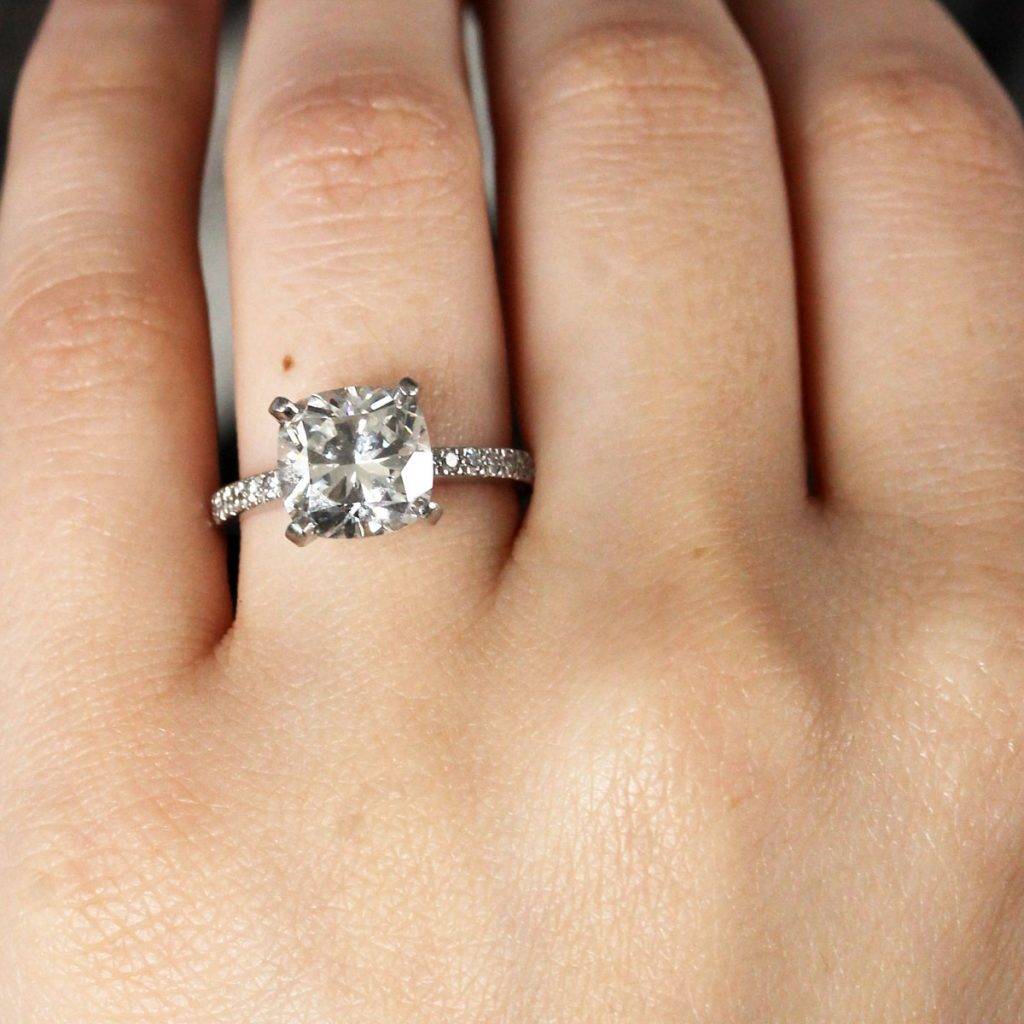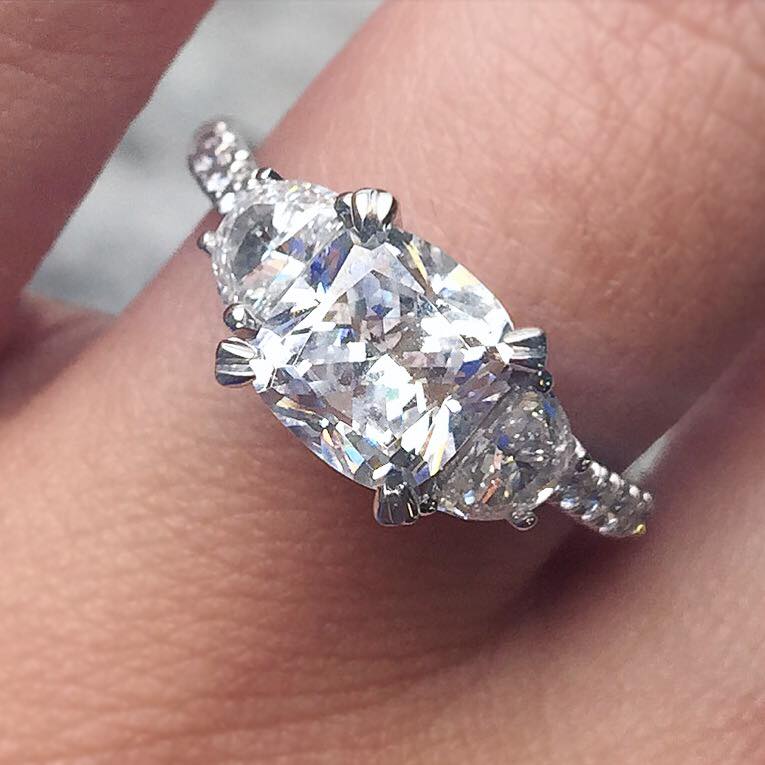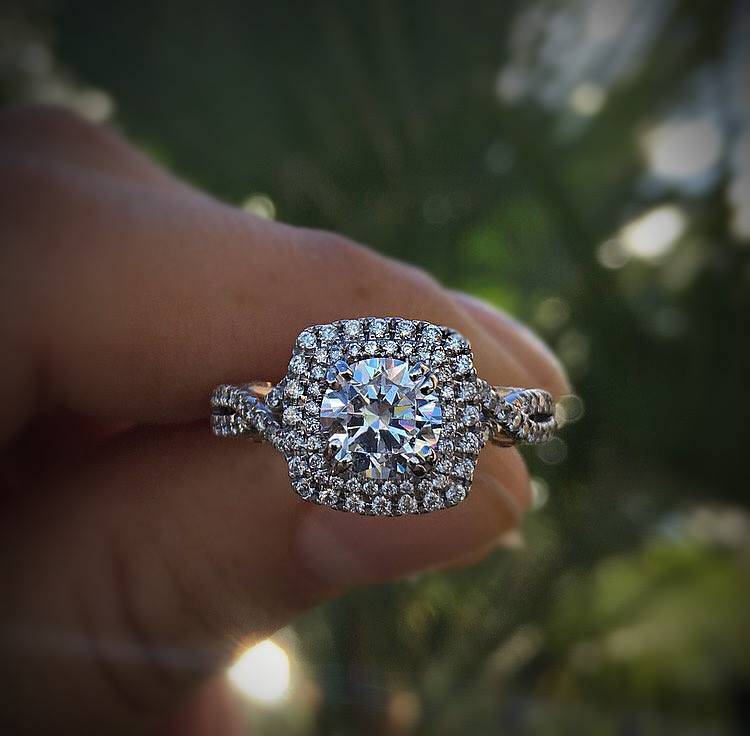
Cushion Cut Diamonds: Facts & History
Cushion cut diamonds are today’s hottest diamond shape. While round brilliant diamonds remain the most purchased, we have to take into account their use in allllll the jewelry that aren’t engagement rings. But when it comes to bridal, cushion cut engagement rings are the most requested diamond shape. So today we want to dive deep into the cushion cut diamond, its history, and just what makes it so special.
 Click here to shop.[/caption]
In the beginning of precious gem history, there was a cushion cut diamond. The cushion cut might be the trendiest shape of all time, but it’s not by any means new. Some of the oldest cut and polished diamonds are, in fact, cushion shaped.
Rose cut, single cut, and Old European cut diamonds all stemmed from the first shape, which was cushion. The modern development of today’s cushion cut began in the 1700’s in Brazilian diamond mines, also known as “the old mines” once the South African diamond mines were discovered. You see where we’re going here? The famed Old Mine or Old Miner cut diamonds, a soft square with rounded corners, was the predecessor of today’s dazzling cushion cut.
This shape has always been popular, because Old Mine cut diamonds ruled the gemstone scene well into the late 19th century – not just for diamonds either. The shape was so popular and so easy to cut that it was the predominant shape for all precious gems. Why’s that?
Click here to shop.[/caption]
In the beginning of precious gem history, there was a cushion cut diamond. The cushion cut might be the trendiest shape of all time, but it’s not by any means new. Some of the oldest cut and polished diamonds are, in fact, cushion shaped.
Rose cut, single cut, and Old European cut diamonds all stemmed from the first shape, which was cushion. The modern development of today’s cushion cut began in the 1700’s in Brazilian diamond mines, also known as “the old mines” once the South African diamond mines were discovered. You see where we’re going here? The famed Old Mine or Old Miner cut diamonds, a soft square with rounded corners, was the predecessor of today’s dazzling cushion cut.
This shape has always been popular, because Old Mine cut diamonds ruled the gemstone scene well into the late 19th century – not just for diamonds either. The shape was so popular and so easy to cut that it was the predominant shape for all precious gems. Why’s that?
 Click here to shop.[/caption]
Today’s cushion cut diamonds benefit from the advanced technology available combined with skilled diamond cutters well-versed in the old traditions. The modern cushion cut is a square or elongated square with rounded corners and gently convex sides.
They usually have for or eight kite-shaped facets between the girdle and culet (click here to learn more about these terms.) However, there are several proprietary styles of cushion cut diamonds, like those of our Henri Daussi engagement rings.
Click here to shop.[/caption]
Today’s cushion cut diamonds benefit from the advanced technology available combined with skilled diamond cutters well-versed in the old traditions. The modern cushion cut is a square or elongated square with rounded corners and gently convex sides.
They usually have for or eight kite-shaped facets between the girdle and culet (click here to learn more about these terms.) However, there are several proprietary styles of cushion cut diamonds, like those of our Henri Daussi engagement rings.
 Click here to shop.[/caption]
Cushion cut diamonds lend themselves nicely to a ton of variety. The ideal cushion cut for you depends largely on your preferences – more square or elongated, more facets (crushed ice style) or fewer facets (closer to a rose cut), etc. So what’s really important is shopping with the basics for all diamonds in mind. Other than that…
Click here to shop.[/caption]
Cushion cut diamonds lend themselves nicely to a ton of variety. The ideal cushion cut for you depends largely on your preferences – more square or elongated, more facets (crushed ice style) or fewer facets (closer to a rose cut), etc. So what’s really important is shopping with the basics for all diamonds in mind. Other than that…
 Click here to shop.[/caption]
Have any questions about cushion cut diamonds, or any diamond shape? Chat with us today and we’ll be happy to help.
Click here to shop.[/caption]
Have any questions about cushion cut diamonds, or any diamond shape? Chat with us today and we’ll be happy to help.
History
[caption id="attachment_104790" align="alignnone"size-large] Click here to shop.[/caption]
In the beginning of precious gem history, there was a cushion cut diamond. The cushion cut might be the trendiest shape of all time, but it’s not by any means new. Some of the oldest cut and polished diamonds are, in fact, cushion shaped.
Rose cut, single cut, and Old European cut diamonds all stemmed from the first shape, which was cushion. The modern development of today’s cushion cut began in the 1700’s in Brazilian diamond mines, also known as “the old mines” once the South African diamond mines were discovered. You see where we’re going here? The famed Old Mine or Old Miner cut diamonds, a soft square with rounded corners, was the predecessor of today’s dazzling cushion cut.
This shape has always been popular, because Old Mine cut diamonds ruled the gemstone scene well into the late 19th century – not just for diamonds either. The shape was so popular and so easy to cut that it was the predominant shape for all precious gems. Why’s that?
Click here to shop.[/caption]
In the beginning of precious gem history, there was a cushion cut diamond. The cushion cut might be the trendiest shape of all time, but it’s not by any means new. Some of the oldest cut and polished diamonds are, in fact, cushion shaped.
Rose cut, single cut, and Old European cut diamonds all stemmed from the first shape, which was cushion. The modern development of today’s cushion cut began in the 1700’s in Brazilian diamond mines, also known as “the old mines” once the South African diamond mines were discovered. You see where we’re going here? The famed Old Mine or Old Miner cut diamonds, a soft square with rounded corners, was the predecessor of today’s dazzling cushion cut.
This shape has always been popular, because Old Mine cut diamonds ruled the gemstone scene well into the late 19th century – not just for diamonds either. The shape was so popular and so easy to cut that it was the predominant shape for all precious gems. Why’s that?
“The defining characteristics of an old mine cut diamond are a squarish shape with a high crown (top), small table, deep pavilion (bottom), and a large culet. Historically, diamond cutting was a slow and difficult process and diamond cutters were limited by the technology available at the time. Retaining as much weight from the rough diamond as possible was important to save time and money. The old mine cut was most conducive to accommodate these cutting limitations.”- GIA
Typical Specs
[caption id="attachment_110118" align="alignnone"size-large] Click here to shop.[/caption]
Today’s cushion cut diamonds benefit from the advanced technology available combined with skilled diamond cutters well-versed in the old traditions. The modern cushion cut is a square or elongated square with rounded corners and gently convex sides.
They usually have for or eight kite-shaped facets between the girdle and culet (click here to learn more about these terms.) However, there are several proprietary styles of cushion cut diamonds, like those of our Henri Daussi engagement rings.
Click here to shop.[/caption]
Today’s cushion cut diamonds benefit from the advanced technology available combined with skilled diamond cutters well-versed in the old traditions. The modern cushion cut is a square or elongated square with rounded corners and gently convex sides.
They usually have for or eight kite-shaped facets between the girdle and culet (click here to learn more about these terms.) However, there are several proprietary styles of cushion cut diamonds, like those of our Henri Daussi engagement rings.
What to look for in cushion cut diamonds
[caption id="attachment_114872" align="alignnone"size-large] Click here to shop.[/caption]
Cushion cut diamonds lend themselves nicely to a ton of variety. The ideal cushion cut for you depends largely on your preferences – more square or elongated, more facets (crushed ice style) or fewer facets (closer to a rose cut), etc. So what’s really important is shopping with the basics for all diamonds in mind. Other than that…
Click here to shop.[/caption]
Cushion cut diamonds lend themselves nicely to a ton of variety. The ideal cushion cut for you depends largely on your preferences – more square or elongated, more facets (crushed ice style) or fewer facets (closer to a rose cut), etc. So what’s really important is shopping with the basics for all diamonds in mind. Other than that…
- Look for symmetry, regardless of the proportions you like. The four corners should be as close to identical as possible, as should the curves of each side.
- The thickness of a cushion cut diamond’s girdle swells closer to the corners, and gets thinner in between. If you fall in love with a cushion cut that has a “very thin” girdle, just be aware that it’s more prone to chipping, and you should consider a protective mounting style.
- Cushion cuts have a facet pattern all their own, and it varies from style to style. If you want more brilliance, you want more facets. But cushion cuts, while they do have more facets than round brilliants (64 vs. 58) have a different type of sparkle and are slightly less brilliant. But still just as gorgeous.
- Cushion cut diamonds look excellent in a variety of settings, but our favorite ways to play with their distinctive shape is to set them in a halo or solitaire.
- If you like the look of a cushion shape, but want the brilliance of a round diamond, you can set a classic RB in one of our famous soft square halos. You get the best of both worlds and we love this look.
 Click here to shop.[/caption]
Have any questions about cushion cut diamonds, or any diamond shape? Chat with us today and we’ll be happy to help.
Click here to shop.[/caption]
Have any questions about cushion cut diamonds, or any diamond shape? Chat with us today and we’ll be happy to help.
